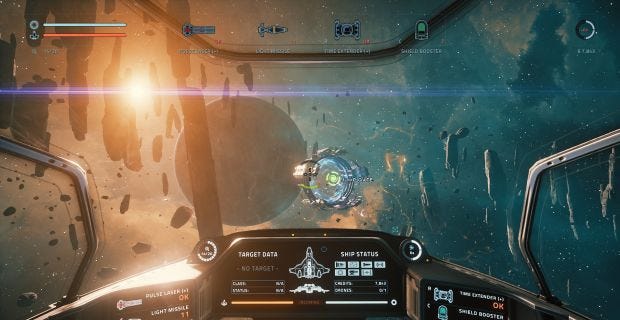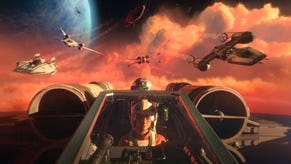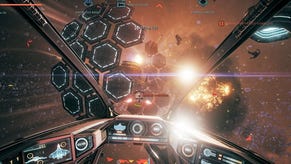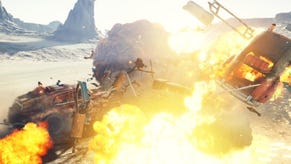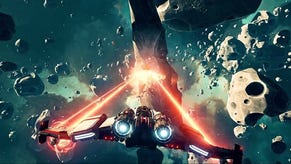Wot I Think: Everspace
Sans VR
Sci-fi dogfighter Everspace [official site] has been stuck in the early access nebula since September last year. But last month it turned up the warp crank and charged the star batteries to "quite full". Zoom! It’s a roguelike that our Alec took a peep at once before. But it's properly out now, so I’m going to tell you wot I think.
It’s an arcadey, gun-swapping dance of asteroids and explosions. I’d call all the boosting and lasering and missile-launching a “ballet” but that would imply some finesse on the part of the pilot, whereas I have none. Nevertheless, it’s a better-than-average dogfighting sim - uppercase “DOGFIGHTING”, lowercase “sim”.
The tale is straightforward. You’re a clone with amnesia because this is a videogame and you have to jump from sector to sector to earn flashbacks of your origins. A computer voice is there to help you and periodically fills you in on the half-hearted politics of the universe (some reptile aliens called the Okkar did a war with humanity, then the war ended but they still don’t like each other).
The story, delivered with voiceovers and moving sketches that appear between sectors, doesn’t matter much. You’re here to shoot. Primary weapons? Let’s see, pulse lasers, gatling guns, fusion cannons, beam lasers, flak cannons… okay, check! Secondary weapons? Light missile, heavy missiles, shield breaker missiles, another bigger, explodier missile… check! There are also different modules and consumables that come in handy, like drones that will fight for you or recharge your shield. Or mines that you can drop behind you. Or anti-missile point defenses. Or a “time extender” that will slow everything down for 20 seconds or so and make any dialogue audio gooo realllyyyy sloooooow iiin the moooost comicaaaaal waaaaaay.
But the Okkar, not the story of them, are what drive you on. After warping into each new area you only have a limited time to blow folks up, loot their corpses, explore a little, rummage through derelicts, and slurp up any plasma, gas, credits or fuel lying around. Sooner or later a red blinking light and buzzer will warn you of imminent super-powerful Okkar ships, coming to have a go because they think they're hard enough (they are). Point your ship at the exit and warp away before they come and shred you to bits. You’re greeted with an FTL style starmap, letting you choose which system to hop to next. At the end of every sector there’s a warp gate that takes you to an entirely new sector, and new starmap, with the difficulty hike that this entails.
Fuel is an important commodity in this respect, much more so than the ore, plasma, crystals and scrap that allows you to upgrade your weapons and craft new consumables or ammo. If your tank is empty and you try to jump on fumes, you’ll be warned that it can severely damage your ship. It’s sometimes worth the risk, if the Okkar are already there and there’s no time to look for the nearest abandoned petrol station, why not press the “maybe you’ll die” button? I’ve gone bust a couple of times to this dice roll, but I don’t regret making the bet. And anyway that’s a poor metaphor, you never really “go bust” in this game because every death lets you cash in your chips.
That's because you are able to upgrade your spaceride between deaths, banking all the credits you clutched to your breast while exploding. This is done via an inter-death tech tree of sorts. On top of extra weapons slots or space for more consumables there are extra hull points, better credit drop rates, higher critical hit chance upgrades, fuel efficiency, and all different kinds of incremental stat boost. Earn enough cash and you can unlock new types of ship – a light, stealth-ready fighter, or a heavy but shieldless gunship.
One odd element of this menu is that each perk demands multiple injections of cash just to reach its next “level”, each injection more expensive than the last. This is good if you die and want to spread your credits all over the menu, slowly building up a better ship. But feels like more of a rip-off if you’re the type of player who likes to secure one or two skills at a time. Even during my most wealthy cashing-in periods I often came away feeling like I’d unlocked nothing particularly exciting or useful. A bump in stats, and not much more. I’d earned an extra centimetre of padding in the soles of my shoes, when what I really wanted was some roller-wheels installed in the heel, or maybe those red lights that blink with every step.
The roguelikeness of this is emphasised from the start then. This is not a space sim in the traditional sense. There’s very little “downtime” between bouts of combat and you can’t ignore the fighting altogether and survive by salvaging bits of old freighters, or make a living by running sardines from one space station to another. It’s an action movie set in space, not hard sci-fi you can indulge in while listening to Radio 4.
Although, it does lift enough tricks from its brother genre to add some variety. Your ship’s systems can get damaged, for example, altering the way you play and forcing you to fly differently. When your primary weapons get banjaxed, they fire slower, forcing you to rely on missiles, or encouraging you to try to kite enemies towards fighters of another human force called the G&B, a corporation who are neutral to you by default but who will get nasty if you steal their space oil. When your life support is damaged, your oxygen starts to slowly tick down, meaning you need to repair it asap. Another resource – nano bots – is necessary to fix any broken system, but these also weld up bulletholes in your hull, so applying them where needed is often a balancing act.
Likewise, there are traders who’ll do rigid deals with you, and the occasional sub-quest will be automatically added to your HUD by the computer – something that’ll earn you credits from nearby humans. These additions add a bit of spice to the dogfighting, leading to sim-like moments when your missiles won’t fire and your air is running out and oh god here come the Okkar and I haven’t got enough fuel and I haven’t collected enough nanobots to repair before the jump and I’m in the middle of an electrical spacestorm and I’m probably going to die but let’s gooooooooo!
Boop. Well, look at that, you’re still alive.
Like I said in our recent podpod, this kind of moment will probably happen to everyone, because the game is tilted in such a way that it always happens. But that’s the joy of roguelikes, there’s always a point where the downfall seems inevitable and you somehow scrape your way out of it like a newly born lizard escaping from a den of snakes. Fans of that feeling, and those seeking its quick and easy sci-fi replication without investing dozens of hours grinding or losing thousands of space credits in the process, will appreciate this game’s no-nonsense delivery of those “oh no I’m deffo dead this time wait what” moments.
And yet, I’ve still described it only as a “better-than-average” game. This is largely down to one thing: the controls. By default your firing reticule is independent of your ship’s facing direction. In other words, where your guns point and where your nose points can be totally different. The sensitivity of this reticule is also uncomfortably high. All this can be rejigged, thankfully, but even after doing so it still feels off. I suspect this is because it has been designed from the thrusters up as a VR experience first, with the ability to look around being extra important, and that focus seems to have affected the way non-headset users like me will have to play. The independent reticule feels floaty and weird, but the fixed reticule means it’s a bit harder to follow everything, since you can't look around.
It doesn’t completely ruin the dogfighting though, and it’s hard to tell if my battle with the controls is a fault of Everspace, or simply the result of being spoiled for over a hundred hours by the joystick controls of Elite Dangerous (Everspace has no joystick or HOTAS option, and the gamepad controls are worse than the keyboard and mouse, with even the developers recommending the use of the latter). After swapping out the floating reticule for the fixed-in-the-middle crosshair and dying a few more times to missile silos embedded in otherwise barren spacerocks, I did start to get a feel for the ship’s slidey zero-gravity tango. At least until my inertia dampeners were destroyed and my ultra heavy gunship started to drift around like some kind of drunk bowling ball.
That’s really the appeal here – Everspace is at its best when one or two bits of your ship are busted and you have to improvise slightly during fights and prioritise finding the nearest mechanic station or a pile of nanobots. When the pressure is on and it embraces those sim-lite incidents, it can overcome its dogfighting simplicity and dainty flight controls. For me, however, I’m not sure that's enough to keep playing. When I rollick around in space I want a big universe and the ability to go into orbit around any planet, not "these seven planets". I also like to take my time, have quiet moments when I can appreciate the beauty of space (and that's an extra pity here because just look at these screenshots – it is ravishing). But it's difficult to stop and smell the vacuum when what matters most is pew-pew-pew and the rapid onward push to the next sector. But that's just me. If you want noise, combat, speed and the occasional hurried decision, developers Rockfish have you covered.
They also resisted calling it “eVRspace”, so well done for that.
Everspace is out now on Windows and Mac via Steam, Humble and GOG for £23/$30/€28.
